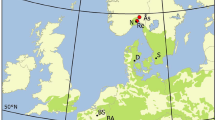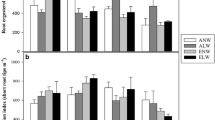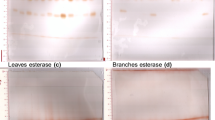Abstract
Dwarf birch (Betula nana L.), a dominant deciduous dwarf shrub in many tundra ecosystems, is predicted to increase substantially in abundance due to climate warming. Potential warming-induced changes in the concentrations of phenolic compounds in B. nana leaves could influence the susceptibility of B. nana to environmental stresses; however, only a few studies have investigated the effects of climate warming on the phenolic defence in B. nana. We analysed the responses of phenolic concentrations and amounts in B. nana leaves to factorial treatments of warming and fertilization for 2 years in a subarctic tundra heath. Warming induced a strong decrease in total phenolics, including both flavonols (i.e. quercetin and myricetin derivatives, important defence compounds against oxidative stress) and hydrolysable tannins (HTs, important defence compounds against herbivory). Fertilization exerted weaker effects on phenolic concentrations while significantly increasing the leaf area. Our data indicate that climate warming may decrease the level of phenolic defence in B. nana leaves. Given the important role of these compounds in the plant defence, this phenomenon could potentially increase the susceptibility of B. nana to biotic stresses such as herbivory.





Similar content being viewed by others
References
Abràmoff MD, Magalhäes PJ, Ram SJ (2004) Image processing with imageJ. Biophotonics Int 7:36–43
Anttila U, Julkunen-Tiitto R, Rousi M, Yang S, Rantala MJ, Ruuhola T (2010) Effects of elevated ultraviolet-B radiation on a plant–herbivore interaction. Oecologia 164:163–175
Ayres MP, Clausen TP, MacLean SF, Redman AM, Reichardt PB (1997) Diversity of structure and antiherbivore activity in condensed tannins. Ecology 78:1696–1712
Barbehenn RV, Jones CP, Hagerman AE, Karonen M, Salminen J-P (2006) Ellagitannins have greater oxidative activities than condensed tannins and galloyl glucoses at high pH: potential impact on caterpillars. J Chem Ecol 32:2253–2267
Bokhorst S, Huiskes A, Coney P, Sinclair BJ, Lebouvier M, Van de Vijver B, Wall DH (2011) Microclimate impacts of passive warming methods in Antarctica: implications for climate change studies. Polar Biol 34:1421–1435
Bret-Harte MS, Shaver GR, Zoerner JP, Johnstone JF, Wagner JL, Chavez AS, Gunkelman RFIV, Lippert SC, Laundre JA (2001) Developmental plasticity allows Betula nana to dominate tundra subjected to an altered environment. Ecology 82:18–32
Bret-Harte MS, Mack MC, Goldsmith GR, Sloan DB, DeMarco J, Shaver GR, Ray PM, Biesinger Z, Chapin FS III (2008) Plant functional types do not predict biomass responses to removal and fertilization in Alaskan tussock tundra. J Ecol 96:713–726
Bryant JP, Provenza FD, Pastor J, Reichardt PB, Clausen TP, du Toit JT (1991) Interactions between woody plants and browsing mammals mediated by secondary metabolites. Annu Rev Ecol Syst 22:431–446
Carmona D, Lajeunesse MJ, Johnson MTJ (2011) Plant traits that predict resistance to herbivores. Funct Ecol 25:358–367
Chapin FS, Shaver GR (1985) Individualistic growth response to tundra plant species to environmental manipulations in the field. Ecology 66:564–576
Close DC, McArthur C (2002) Rethinking the role of many plant phenolics: protection from photodamage not herbivores? Oikos 99:166–172
Coq S, Souquet J-M, Meudec E, Cheynier V, Hättenschwiler S (2010) Interspecific variation in leaf litter tannin drives decomposition in a tropical rain forest of French Guiana. Ecology 91:2080–2091
Crete M, Doucet GJ (1998) Persistent suppression in dwarf birch after release from heavy summer browsing by caribou. Arct Alp Res 30:126–132
Elmendorf S, Henry GHR, Hollister RD et al (2012) Global assessment of experimental climate warming on tundra vegetation: heterogeneity over space and time. Ecol Lett 15:164–175
Graglia E, Jonasson S, Michelsen A, Schmidt IK, Havström M, Gustavsson L (2001a) Effects of environmental perturbations on abundance of subarctic plants after three, seven and ten years of treatments. Ecography 24:5–12
Graglia E, Julkunen-Tiitto R, Shaver G, Schmidt IK, Jonasson S, Michelsen A (2001b) Environmental control and intersite variations of phenolics in Betula nana in tundra ecosystems. New Phytol 151:227–236
Hamilton JG, Zangerl AR, DeLucia EH, Berenbaum MR (2001) The carbon-nutrient balance hypothesis: its rise and fall. Ecol Lett 4:86–95
Hansen AH, Jonasson S, Michelsen A, Julkunen-Tiitto R (2006) Long-term experimental warming, shading and nutrient addition affect the concentration of phenolic compounds in arctic–alpine deciduous and evergreen dwarf shrubs. Oecologia 147:1–11
Hollister RD, Webber PJ (2000) Biotic validation of small open-top chambers in a tundra ecosystem. Glob Change Biol 6:835–842
Jepsen JU, Hagen SB, Ims RA, Yoccoz NG (2008) Climate change and outbreaks of the geometrids Operophtera brumata and Epirrita autumnata in subarctic birch forest: evidence of a recent outbreak range expansion. J Anim Ecol 77:257–264
Jonasson S, Bryant JP, Chapin FS III, Anderson M (1986) Plant phenols and nutrients in relation to variations in climate and rodent grazing. Am Nat 128:394–408
Kaarlejärvi E, Baxter R, Hofgaard A, Hytteborn H, Khitun O, Molau U, Sjögersten S, Wookey P, Olofsson J (2012) Effects of warming on shrub abundance and chemistry drive ecosystem-level changes in a forest-tundra ecotone. Ecosystems 15:1219–1233
Kaukonen M, Ruotsalainen AL, Wäli P, Männistö MK, Setälä H, Saravesi K, Huusko K, Markkola AM (2013) Moth herbivory enhances resource turnover in subarctic mountain birch forests? Ecology 94:267–272
Keski-Saari S, Pusenius J, Julkunen-Tiitto R (2005) Phenolic compounds in seedlings of Betula pubescens and B. pendula are affected by enhanced UVB radiation and different nitrogen regimens during early ontogeny. Glob Change Biol 11:1180–1194
Koricheva J (1999) Interpreting phenotypic variation in plant allelochemistry: problems with the use of concentrations. Oecologia 119:467–473
Koricheva J, Larsson S, Haukioja E, Keinänen M (1998) Regulation of woody plant secondary metabolism by resource availability: hypothesis testing by means of meta-analysis. Oikos 83:212–226
Kostina E, Wulff A, Julkunen-Tiitto R (2001) Growth, structure, stomatal responses and secondary metabolites of birch seedlings (Betula pendula) under elevated UV-B radiation in the field. Trees 15:483–491
Kumpula J, Stark S, Holand O (2011) Seasonal grazing effects by semi-domesticated reindeer on subarctic mountain birch forests. Polar Biol 34:441–453
Larson RA (1988) The antioxidants of higher plants. Phytochemistry 27:969–978
Mack MC, Schuur EAG, Bret-Harte MS, Shaver GR, Chapin FS III (2004) Ecosystem carbon storage in arctic tundra reduced by long-term nutrient fertilization. Nature 431:440–443
Marion GM, Henry GHR, Freckman DW, Johnstone J, Jones G, Jones MH, Lévesque E, Molau U, Molgaard P, Parsons AN, Svoboda J, Virginia RA (1997) Open-top designs for manipulating field temperature in high latitude ecosystems. Glob Change Biol 3:20–31
Martz F, Sutinen M-L, Derome K, Wingsle G, Julkunen-Tiitto R, Turunen M (2007) Effects of ultraviolet (UV) exclusion on the seasonal concentration of photosynthetic and UV-screening pigments in Scots pine needles. Glob Change Biol 13:252–265
Martz F, Jaakola L, Julkunen-Tiitto R, Stark S (2010) Phenolic composition and antioxidant capacity of bilberry (Vaccinium myrtillus) leaves in northern Europe following foliar development and along environmental gradients. J Chem Ecol 36:1017–1028
Martz F, Turunen M, Julkunen-Tiitto R, Suokanerva H, Sutinen M-L (2011) Different responses of two reindeer forage plants to enhanced UV-B radiation: modification of the phenolic composition. Polar Biol 34:411–420
Myers-Smith IH, Forbes BC, Wilmking M, Hallinger M, Lantz T, Blok D, Tape KD, Macias Fauria M, Sass-Klaassen U, Lévesque E, Boudreau S, Ropars P, Hermanutz L, Trant A, Collier LS, Weijers S, Rozema J, Rayback SA, Schmidt NM, Schaepman-Strub G, Wipf S, Rixen C, Ménard CB, Venn S, Goetz S, Andreu-Hayles L, Elmendorf S, Ravolainen V, Welker JM, Grogan P, Epstein HE, Hik DS (2011) Shrub expansion in tundra ecosystems: dynamics, impacts and research priorities. Environ Res Lett 6:045509
Nybakken L, Klanderud K, Totland O (2008) Simulated environmental change has contrasting effects on defensive compound concentrations in three alpine plant species. Arct Antarct Alp Res 40:709–715
Nybakken L, Sandvik SM, Klanderud K (2011) Experimental warming had little effect on carbon-based secondary compounds, carbon and nitrogen in selected alpine plants and lichens. Environ Exp Bot 72:368–376
Oksanen L, Virtanen R (1995) Topographic, altitudinal and regional patterns in continental and suboceanic heath vegetation of northern Fennoscandia. Acta Botanica Fennica 153:1–80
Ossipov V, Haukioja E, Ossipova S, Hanhimäki S, Pihlaja K (2001) Phenolic and phenolic-related factors as determinants of suitability of mountain birch leaves to an herbivorous insect. Biochem Syst Ecol 29:223–240
Ossipov V, Klemola T, Ruohomäki K, Salminen J-P (2014) Effects of three years’ increase in density of the geometric Epirrita autumnata on the change in metabolome of mountain birch trees (Betula pubescens ssp. czerepanovii). Chemoecology 24:201–214
Persson I-L, Julkunen-Tiitto R, Bergström R, Wallgren M, Suominen O, Danell K (2012) Simulated moose (Alces alces L.) browsing increases accumulation of secondary metabolites in bilberry (Vaccinium myrtillus L.) along gradients of habitat productivity and solar radiation. J Chem Ecol 38:1225–1234
Porra RJ, Thompson WA, Kriedemann PE (1989) Determination of accurate extinction coefficients and simultaneous equations for assaying chlorophylls a and b extracted with four different solvents: verification of the concentration of chlorophyll standards by atomic absorption spectroscopy. Biochim Biophys Acta 975:384–394
Porter LJ, Hrstich LC, Chan BG (1986) The conversion of procyanidins and prodelphinidins to cyanidin and delphinidins. Phytochemistry 25:223–230
Randriamanana TR, Nybakken L, Lavola A, Aphalo PJ, Nissinen K, Julkunen-Tiitto R (2014) Sex-related differences in growth and carbon allocation to defence in Populus tremula as explained by current plant defence theories. Tree Physiol 34:471–487
Rice-Evans CA, Miller NJ, Paganga G (1996) Structure-antioxidant activity relationships of flavonoids and phenolic acids. Free Radic Biol Med 20:933–956
Rice-Evans CA, Miller NJ, Paganga G (1997) Antioxidant properties of phenolic compounds. Trends Plant Sci 2:152–159
Riipi M, Ossipov V, Lempa K, Haukioja E, Koricheva J, Ossipova S, Pihlaja K (2002) Seasonal changes in birch leaf chemistry: are there trade-offs between leaf growth and accumulation of phenolics? Oecologia 130:380–390
Riipi M, Lempa K, Haukioja E, Ossipov V, Pihlaja K (2005) Effects of simulated winter browsing on mountain birch foliar chemistry and on the performance of insect herbivores. Oikos 111:221–234
Ruohomäki K, Chapin FS III, Haukioja E, Neuvonen S, Suomela J (1996) Delayed inducible resistance in mountain birch in response to fertilization and shade. Ecology 77:2302–2311
Ruuhola T, Yang S (2006) Wound-induced oxidative responses in mountain birch leaves. Ann Bot 97:29–37
Ruuhola T, Salminen J-P, Haviola S, Yang S, Rantala MJ (2007) Immunological memory of mountain birches: effects of phenolics on performance of the autumnal moth depend on herbivory history of trees. J Chem Ecol 33:1160–1176
Ruuhola T, Salminen P, Salminen JP, Ossipov V (2013) Ellagitannins: defences of Betula nana against Epirrita autumnata folivory? Agric For Entomol 15:187–196
Salminen JP, Karonen M (2011) Chemical ecology of tannins and other phenolics: we need a change in approach. Funct Ecol 25:325–338
Soininen EM, Zinger L, Gielly L, Bellemain E, Bråthen KA, Brochmann C, Epp ES, Gussarova G, Hassel K, Henden J-A, Killengreen ST, Rämä T, Stenøien HK, Yoccoz NG, Ims RA (2013) Shedding new light on the diet of Norwegian lemmings: DNA metabarcoding of stomach content. Polar Biol 36:1069–1076
Stamp N (2003) Out of the quagmire of plant defence hypotheses. Q Rev Biol 78:23–55
Stark S, Julkunen-Tiitto R, Kumpula J (2007) Ecological role of reindeer summer browsing in the mountain birch (Betula pubescens ssp. czerepanovii) forests: effects on plant defense, litter decomposition, and soil nutrient cycling. Oecologia 151:486–498
Stark S, Julkunen-Tiitto R, Holappa E, Mikkola K, Nikula A (2008) Concentrations of foliar quercetin in natural populations of white birch (Betula pubescens) increase with latitude. J Chem Ecol 34:1382–1391
Sundqvist MK, Wardle DA, Olofsson E, Giesler R, Gundale MJ (2012) Chemical properties of plant litter in response to elevation: subarctic vegetation challenges phenolic allocation theories. Funct Ecol 26:1090–1099
Theis N, Lerdau M (2003) The evolution of function in plant secondary metabolites. Int J Plant Sci 163(3 Suppl):S93–S102
Torp M, Olofsson J, Witzell J, Baxter R (2010a) Snow-induced changes in dwarf shrub chemistry increase moth larval growth rate and level of herbivory. Polar Biol 33:693–702
Torp M, Witzell J, Baxter R, Olofsson J (2010b) The effect of snow on plant chemistry and invertebrate herbivory: experimental manipulations along a natural snow gradient. Ecosystems 13:741–751
Turunen M, Soppela P, Kinnunen H, Sutinen M-L, Martz F (2009) Does climate change influence the availability and quality of reindeer forage plants? Polar Biol 32:813–832
Väisänen M, Martz F, Kaarlejärvi E, Julkunen-Tiitto R, Stark S (2013) Phenolic responses of mountain crowberry (Empetrum nigrum ssp. hermaphroditum) to global climate change are compound specific and depend on grazing by reindeer (Rangifer tarandus). J Chem Ecol 39:1390–1399
Väisänen M, Ylänne H, Kaarlejärvi E, Sjögersten S, Olofsson J, Crout N, Stark S (2014) Consequences of warming on tundra carbon balance determined by reindeer grazing history. Nat Clim Change 4:384–388
Walker MD, Wahren CH, Hollister RD, Henry GH, Ahlquist LE, Alatalo JM, Bret-Harte MS, Calef MP, Callaghan TV, Carroll AB, Epstein HE, Jónsdóttir IS, Klein JA, Magnússon B, Molau U, Oberbauer SF, Rewa SP, Robinson CH, Shaver GR, Suding KN, Thompson CC, Tolvanen A, Totland Ø, Turner PL, Tweedie CE, Webber PJ, Wookey PA (2006) Plant community responses to experimental warming across the tundra biome. PNAS 103:1342–1346
Zamin TJ, Grogan P (2012) Birch shrub growth in the low arctic: the relative importance of experimental warming, enhanced nutrient availability, snow depth and caribou exclusion. Environ Res Lett 7:034027
Acknowledgments
We thank Aarno Niva and Sirkka Aakkonen for helping with field manipulations and Minna Männistö and Lars Ganzert for helping with leaf sampling. We are also grateful to Elina Kaarlejärvi, Sarita Keski-Saari, and three anonymous reviewers for helpful comments on the manuscript. This investigation was funded by Academy of Finland (decision number 218121).
Author information
Authors and Affiliations
Corresponding author
Rights and permissions
About this article
Cite this article
Stark, S., Väisänen, M., Ylänne, H. et al. Decreased phenolic defence in dwarf birch (Betula nana) after warming in subarctic tundra. Polar Biol 38, 1993–2005 (2015). https://doi.org/10.1007/s00300-015-1758-0
Received:
Revised:
Accepted:
Published:
Issue Date:
DOI: https://doi.org/10.1007/s00300-015-1758-0




